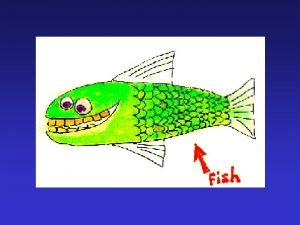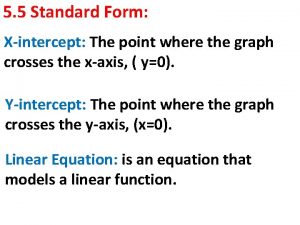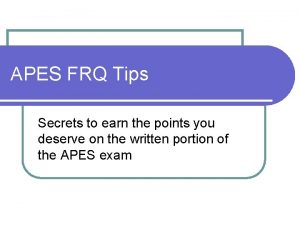APES FRQ Tips Secrets to earn the points












- Slides: 12

APES FRQ Tips Secrets to earn the points you deserve on the written portion of the APES exam

Types of questions One of the four questions will involve the Analysis of a Data Set (Calculators not allowed) l One of the questions will be a Document. Based question. You will have to read a document and answer questions based on that information as well as your general knowledge. l Two questions will be Synthesis and Evaluation. One of these questions will require you to set up an experiment to show some particular effect. l

Structure of the exam You have 90 minutes to write 4 essays. l Plan to use 20 minutes per essay. Leaving 8 minutes to read over your answers and breath a little. l Each essay is graded on a 10 -point scale. Usually the grading rubric is set up to contain slightly more than 10 points (e. g. , 11 -13). However, you can only earn a maximum of 10 points on any one question. l

Look for the points l Each question will have parts labeled: a, b, c, d. Each of these parts have assigned points. You may only earn points for what is asked. l For example: What are 2 colors of the rainbow? l Red and blue are colors of the rainbow. Rainbows are often seen on a sunny day.

Key words for points l Describe l Explain, list and explain l Compare l Give evidence for l Graph l Calculate l Underline these words as you read the question.

Writing your answer Use a ballpoint pen with blue or black ink. Label all parts of the question Spelling, grammar, and sentence structure are important, but you will not lose points as long as you get your ideas across. l Write neatly. If the grader can’t read what you wrote, you will receive no credit. l Use phonetic spelling or explain the concept if you don’t remember the term to describe it. l Leave nothing blank. There is no penalty for incorrect answers. l l l

Have confidence l You will be prepared for this exam. l If you feel panicked, take a deep breath and try to associate the question to something that you have learned in the class. l Success comes to the prepared mind.

Experimental Design FRQs l Think “ 4 points” (1) hypothesis l (2 -3) controls l (1 -2) analysis l

Hypothesis § § Must include the cause and effect specific to the question asked Must be a specific, testable statement Example: Lake trout will no longer survive above a p. H of 8. 0 and will reach 90% survival at a p. H of 7. 2.

Controls l Control group required l Experimental group required l Detailed requirements such as: time, space, materials, sample size Example: The positive control will be trout living in neutral (7. 0) water, the negative control will be trout living in water at a p. H of 8. 0. The experimental groups will be 7. 3 and 7. 7. I will use 10 fish per group for three weeks.

Analysis l Measurement of time l Elaboration l Repeated experiments l Correlation to other experiments l Relate or discuss additional research

Example: Each day I will observe the fish for general health such as feeding behavior. A fish will be considered dead when it floats to the surface. By plotting the percentage of fish living at each p. H, I will estimate the p. H that yields 90% survival. This experiment should be repeated for accuracy and could also be tested with other types of fish.






















